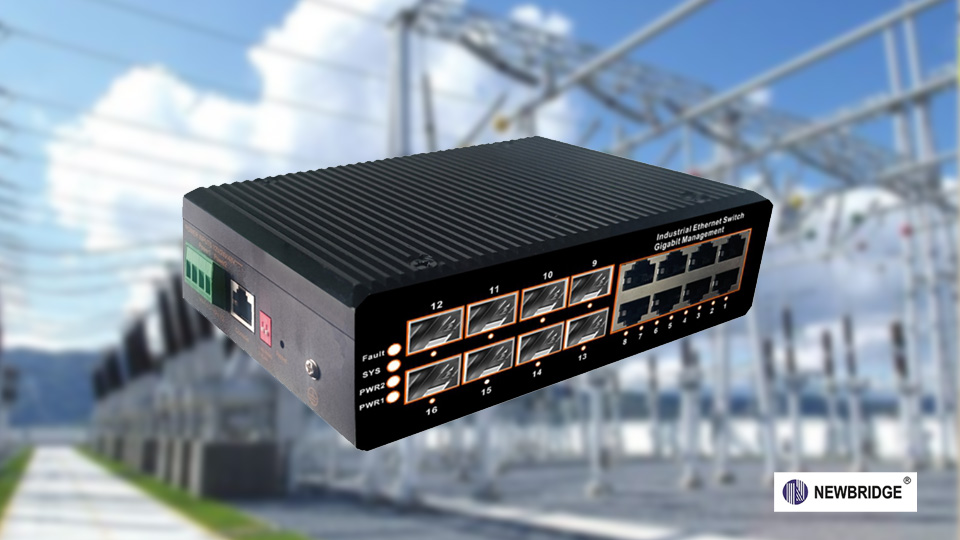The operation of smart grids generates massive amounts of data, and real-time transmission and processing of this data are crucial. Industrial switches, with their high throughput, low latency, and strong anti-interference characteristics, effectively ensure the timely and accurate transmission of power grid data. For example, in a large substation, numerous power equipment such as transformers, circuit breakers, etc. will continuously generate various operational data, such as voltage, current, temperature, etc. By deploying industrial switches, these devices can achieve real-time monitoring and data transmission. With the help of these real-time data, dispatchers can accurately grasp the operation status of the power grid, and once abnormalities are detected, they can quickly make dispatch decisions. Moreover, industrial switches support remote monitoring and management, and operation and maintenance personnel can obtain real-time device status from the monitoring center, timely discover, diagnose, and solve network problems, greatly ensuring the continuous and stable operation of the smart grid.

Realize interconnection and collaborative work of power grid equipment
The smart grid covers many different types of equipment such as power generation equipment, transmission equipment, substation equipment, and distribution equipment. The interconnection and collaborative work between them are the key to ensuring the stable operation of the power grid. Industrial switches ensure smooth communication between devices and systems by providing support for multiple communication protocols, such as common protocols like Modbus and IEC 61850. Meanwhile, industrial switches support hierarchical network topologies, allowing different parts of the smart grid to operate independently. For example, in a regional power grid, different substations and distribution stations can form a hierarchical network through industrial switches. Each subnet can independently monitor and manage local devices, as well as interact with higher-level networks for data exchange, improving the flexibility and scalability of the entire system and enabling grid equipment to work more efficiently together to maintain grid stability.
Optimize power grid scheduling and energy allocation
One of the important development goals of smart grid is to achieve efficient utilization of energy, reduce waste, and lower environmental pollution. Industrial switches play an important role in it. By monitoring and analyzing the operational status of power grid equipment in real-time, industrial switches can provide accurate energy demand forecasting for the power grid. For example, it can predict the energy demand for a certain period of time in the future based on electricity consumption data from different periods and regions, as well as operating parameters of power generation equipment. Based on these predicted information, power grid dispatchers can achieve optimized scheduling of the power grid and allocate energy reasonably. For example, during periods of low electricity consumption, appropriately reducing the output of some power generation equipment; In the peak period of power consumption, adjust the power generation plan in advance to ensure the power supply. In addition, industrial switches can also be combined with 5G technology. The high bandwidth and low latency characteristics of 5G can further improve data transmission speed and response efficiency, promote the development of smart grids towards a smarter and more efficient direction, help improve the economic benefits of the power grid, reduce operating costs, and help achieve sustainable energy development.
Ensure the security of smart grid data
The smart grid involves a large amount of sensitive data, and data security is crucial. Industrial switches use network isolation technology and advanced security protocols, such as firewall technology and SSL/TLS encryption protocols, to effectively prevent network attacks. It also has data encryption and identity authentication functions, and only authorized devices and users can access and transmit data, ensuring the security of various systems in the smart grid. For example, in remote meter reading systems, industrial switches encrypt and transmit meter data to prevent data theft or tampering; In the power dispatching system, identity authentication ensures that only authorized dispatchers can operate relevant equipment, ensuring the safety and reliability of power grid dispatching.
Adapt to the flexible expansion needs of the smart grid
With the development of smart grids, new devices are constantly being connected and the system scale continues to expand. Industrial switches have strong flexibility and scalability through modular design. Users can flexibly choose different modules for configuration according to their actual needs. For example, when it is necessary to increase the number of network ports, corresponding port modules can be added; To improve network transmission speed, you can replace the module that supports higher speeds. Moreover, industrial switches support hierarchical network topology, allowing smart grids to easily expand their network scale by adding devices at the corresponding level during expansion, adapting to the constantly changing and upgrading needs of smart grids.
In the construction of smart grid, industrial switches play an irreplaceable role in multiple aspects such as data transmission, equipment interconnection, energy scheduling, security assurance, and system expansion. As a professional industrial switch manufacturer, we have a wide range of industrial switch products that can meet the application needs of different scenarios in the smart grid. If you are participating in the construction of smart grid projects or have related equipment procurement needs, please feel free to contact us at any time. We will provide you with professional solutions and high-quality product services, and work together to create a better future for smart grids.
